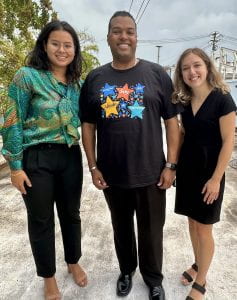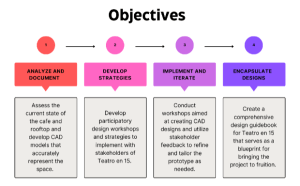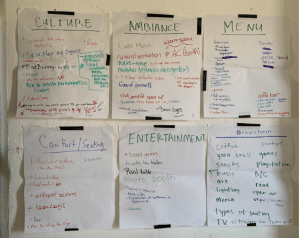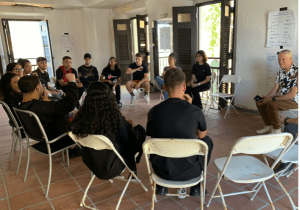Teatro en 15: Opening soon!
Sala Siete: A Space for the Artist in Everyone
Project Sponsor: Teatro en 15
Team Members: Elizabeth Healy and Praniva Pradhan
Project Advisors: Professors Leslie Dodson and Scott Jiusto
- Project Report
- Project Presentation
- A Designer’s Guide
- Cafe and Rooftop Inspiration Book
- Creative Vision Pitch Deck
Abstract:
This project focused on advancing a design for Sala Siete, a ‘third place’ café and rooftop space for Teatro en 15, a microtheater in San Juan, Puerto Rico. The team collaborated with the creative Teatro en 15 community in an iterative participatory design cycle to envision a relaxed artistic hub for artists to connect and create. Workshops and interviews elicited a variety of creative perspectives addressing ‘third place’ characteristics for Sala Siete as a social gathering space. Visions were imagined, discussed, and brought to life in a final CAD design and in our resources for creative collaborative design that include the “From Concept to Creation: A Designer’s Guide,” the “Café and Rooftop Inspiration Book,” and the “Sala Siete: Creative Vision Pitch Deck.”
Executive Summary
Theater has a deep-rooted history in Puerto Rico and is an important part of the island’s cultural heritage. For centuries, theater has served as a means of artistic expression, political commentary, and social critique (Dauster, 1963). Many of the island‘s most celebrated writers, musicians, and actors come from the world of theater; their contributions continuously mold Puerto Rican culture (Dauster, 1963). Theater continues to be an important outlet for creative expression and community engagement in Puerto Rico; many local and national theater companies produce works that not only reflect the island’s unique history and culture, but also interpret present social dynamics and shape the future.
Despite the significance of art in Puerto Rico, theater is often undervalued, with aspiring theater professionals and many theater companies facing an uphill battle to grow their audience and support actors, directors, and writers, including Teatro en 15.
Microtheater
Teatro en 15 (Theater in 15) is a small theater venue in Puerto Rico that offers a space for local artistic and cultural celebration. Located in Old San Juan, the venue opened its doors in 2021 and shows six 15-minute mini-plays each night from Thursday to Sunday. The plays rotate each month, and patrons are taken on a captivating new journey through six stages with each one depicting a unique tale.
According to Alba Florian Vita (2013), modern short-form theater became prominent in 2009 in Spain when Spanish theater producer Miguel Alcantud used a closed-down brothel to put on plays about prostitution. “Microteatro” events are now held in Latin America, the US and around Europe. San Juan’s municipal Director of the Department of Arts and Culture, Antonio Morales Cruz, brought short-form theater to Puerto Rico through Teatro en 15.
Currently, Teatro en 15 has unused space on the third and highest floor connected to the rooftop of a historic building. The arts and culture director saw potential for this space to foster artistic celebration, create connections with other artists, and host social gatherings. Teatro en 15 sees this currently unused space to further its mission in spreading a passion for theater and art. A café might attract patrons to the theater who may only be seeking a cup of coffee yet are nevertheless exposed to theater as a result, and a rooftop performance space could be a relaxed artistic hub for artists and others to connect.
Participatory Design
Participatory design processes involve various stakeholders in the creation of designs that address a range of needs, interests, and goals. Both the designers and the community members play meaningful roles in the co-designing processes. Participatory design is characterized by several aspects. First, it involves spontaneous decision-making that embraces suggestions from the community (Luck, 2018). Building strong relationships with the community and prioritizing their needs through interaction is essential (Rodgers, 2015). There are various tools that participatory designers use to facilitate community collaboration. Holding workshops helps designers understand community concerns and develop strong relationships with stakeholders, augmenting the impact of and support for a design solution (Hwang & Fellow, 2009-2012). Participatory design has benefits over other design processes and theories because it prevents the reduction of people solely to their behaviors and characteristics outside of the context of their community (Dowd, 2019).
Designing a ‘Third Place’
‘Third places’ play vital roles in social interaction since these spaces foster human interaction. In Designing Coffee Shops and Cafes for Community by Lisa Waxman, Waxman (2022) states that these spaces are neutral ground where no one must play the role of host or invitee, and they serve as a leveler or an inclusive place welcoming all people. ‘Third places’ can feature regulars at these establishments and have a playful mood, often becoming a “home away from home.” Place attachment theory suggests that people form attachments to a space when they have a long and intense experience with it, and this space then takes on special meaning for that person. The presence of other people in this space is essential to forming this patron – ‘third place’ attachment (Waxman, 2022).
Project Goal
This project aids San Juan’s Arts and Culture Director Antonio Morales in celebrating Puerto Rican culture through the arts by adding a rooftop café and performance space to Teatro en 15. The team achieved this by implementing an architectural participatory design process and developing thorough CAD models of the proposed space. We had four objectives to meet this goal:
Methods
The project incorporated an analysis of existing rooftop conditions, participatory design strategies, implementation of the iterative participatory design process, CAD drawings, and the development of human-centered design possibilities and engineering considerations. The primary method was to engage the Teatro en 15 community in the iterative participatory design cycle to develop the collaborative design elements.
Participatory design strategies included interviewing four key informants and twelve Teatro en 15 ushers. By incorporating the views of different Teatro en 15 community members, we aimed to incorporate perspectives from their different creative histories into an inspiring design of the café and rooftop space. The most important work the team did was to facilitate three workshops with the Teatro en 15 ushers. We called these participatory design workshops the Café Bulletin Activity, the Café Drawing Activity, and the Rooftop Visualization Activity. In these workshops, the ushers discussed and debated various design elements impacting the human elements, or ‘third place’ relationship, that Sala Siete sought to achieve.
The Café Bulletin Activity was the first workshop held with the ushers where they brainstormed elements for the café that would make it a ‘third place’. The ushers brought their ‘third place’ brainstorms from the Café Bulletin Activity to life in the Café Drawing Activity that followed by creating hand sketches of their visions. The Rooftop Visualization Activity both prompted the ushers to brainstorm essentials of the exterior of Sala Siete and to visualize the space through hand draw sketches.
Findings on the Creative and Rewarding Participatory Design Process
The participatory design workshops yielded substantial collaboration with the Teatro en 15 community and resulted in numerous collaborative designs. The team worked with key stakeholders to advance the design by incorporating their ideas and visions. We prioritized implementing participatory design and collaboration with the Teatro en 15 community through workshops and interviews. The visions that the community shared in this process directly resulted in a design with a cozy, relaxed atmosphere that incorporated Puerto Rican culture and art. The design became a space where art is celebrated, practiced, and used as a tool of connection.
- Integrating design concepts is a vital step in the creative participatory design cycle.
- Hwang’s Theory of Participatory Design needed to be adjusted to accurately represent the team’s participatory design processes.
- Manzini and Rizzo’s Theory of Participatory Design defined our role as facilitators rather than co-designers.
- Personal and creative histories of participants influence and drive designs.
- In the Café Bulletin Activity, ushes analyzed the elements of a ‘third place’ and reflected on how those should take shape in the café.
- Teatro en 15 ushers were eager to participate in our workshops and sparked lively conversation and debate over design elements.
- Ushers brought their ideas on ‘third places’ to life by translating words to visuals during the Café Drawing Activity.
- Ushers addressed ‘third place’ concepts for the exterior space and brought them to life through hand drawn sketches during the Rooftop Visualization Activity.
The above findings were essential in the advancement of the collaborative design: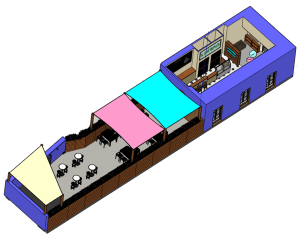
Resources for Creative Collaborative Design
We developed a suite of resources to inspire future creative, collaborative designs. These include the: “From Concept to Creation: A Designer’s Guide,” “Café and Rooftop Inspiration Book,” and the “Sala Siete: Creative Vision Pitch Deck.” Below are pages from “From Concept to Creation: A Designer’s Guide.”
Recommendations
- Recommendations for Facilitators of Participatory Design Workshops
- Plan workshops around participants’ schedules.
- Recognize valuable and unique input.
- Allow for spontaneity during participatory design workshops.
- Build in spare time to the workshop schedule.
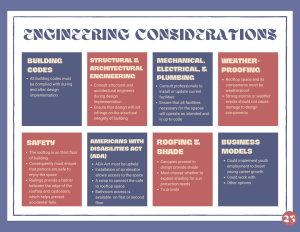 Recommendations for Engineers and Designers
Recommendations for Engineers and Designers
- While we focused primarily on the social importance of ‘third places’ and the desired human connections to Sala Siete throughout the design process, the engineering considerations for design implementation are just as important. Aspects like building codes, accessibility laws, weatherproofing, and facilities are all key to bringing Sala Siete to life.
- Recommendations for future WPI projects
- English translations during performances
- The creation of a website for the theater
Conclusion: Contributing to the creation of the Sala Siete ‘Third Place’
Our collaborative experiences with the Teatro en 15 community addressed all the necessary components of a ‘third place,’ ensuring the advancement of a design for Sala Siete that meets the needs of its patrons. By upholding the Americans with Disabilities (ADA) Act, the Sala Siete design allows people of all physical abilities to use and enjoy the space, meeting the vital need of accessibility characteristic of ‘third places.’ Sala Siete’s purpose of spreading passion for art, promoting connection among artists and art lovers, and providing a safe haven for artists gives the space utility, the next characteristic of ‘third places.’ From providing proper protection on the rooftop to creating a welcoming and relaxed environment, the Sala Siete design has the capabilities to make all patrons feel safe if all engineering considerations are implemented, meeting the next ‘third place’ characteristic of safety. The cozy, relaxed ambience of Sala Siete combined with the opportunities for artistic creation and entertainment it offers meet the highest two characteristics of ‘third places,’ comfort and engagement. Patrons could be attracted to Sala Siete for the food and drink offered, the cozy ambience, the performances on the rooftop stage, or all the above.



